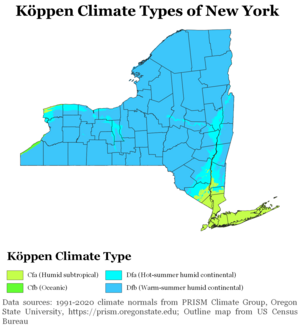

The climate of New York (state) is generally humid continental, while the extreme southeastern portion of the state (New York City and Long Island area) lies in the warmer humid subtropical climate zone. Winter temperatures average below freezing during January and February in much of the state of New York, but several degrees above freezing along the Atlantic coastline, including New York City.
Seasonally, summer-like conditions prevail from June to early September statewide, while areas in far southern New York and New York City have summer conditions from late May through early-mid October. Cold-air damming east of the Appalachians leads to protracted periods of cloud cover and precipitation east of the range, primarily between the October and April months. Winter-like conditions prevail from November through April in northern New York, and from December through March in southern New York. On average, western New York is much cloudier than points south and east in New York, much of it generated from the Great Lakes. Greenhouse gas emission is low on a per-capita basis when compared to most other states due to the extensive use of mass transit, particularly across New York City. The significant urbanization within New York city has led to an urban heat island, which causes temperatures to be warmer overnight in all seasons.
Annual precipitation is fairly even throughout the year across the state of New York. The Great Lakes region of New York sees the highest annual rain and snow amounts in the state of New York, and heavy lake-effect snow is common in both western and central New York in winter. In the hotter months, large, long-lived complexes of thunderstorms can invade the state from Canada and the Great Lakes, while tropical cyclones can bring rains and winds from the southwest during the summer and fall. Hurricane impacts on the state occur once every 18–19 years, with major hurricane impacts every 70–74 years. An average of ten tornadoes touch down in New York annually. Governors Island, Manhattan, in New York Harbor, is planned to host a US$1 billion research and education center poised to make New York City the global leader in addressing the climate crisis.[1]
- ^ "Mayor Adams, Trust For Governors Island Unveil Finalist Proposals For Climate Solutions Center". City of New York. October 26, 2022. Retrieved October 29, 2022.